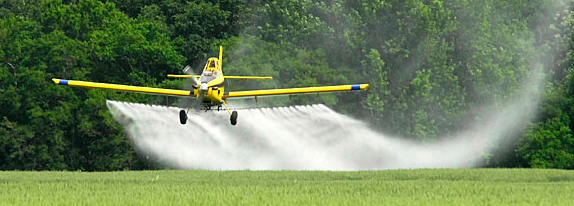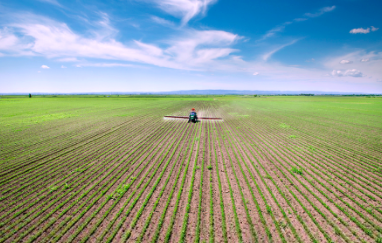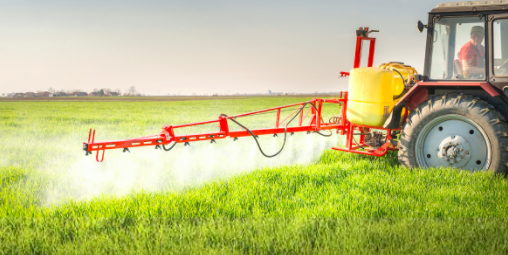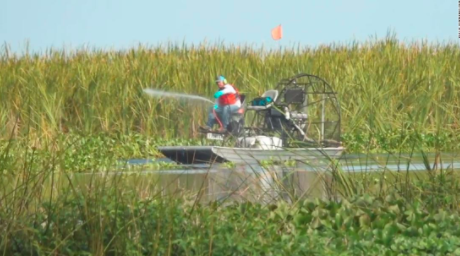EPA Releases Evaluation of Glyphosate Herbicide Impact on Endangered Species
The day before Thanksgiving the EPA released their Biological Evaluation (BE) assessment of potential risks for registered uses of glyphosate to endangered or threatened species or their critical habitat. This federal action is a part of the Registration Review for the license of glyphosate, which has been ongoing for more than ten years, for re approval or denial.

Moms Across America was incredibly disappointed by the actions of the EPA and their refusal to acknowledge the evidence that glyphosate can cause cancer in humans and does cause cancer in animals, as identified by world renowned scientists at the International Agency for Research on Cancer in 2015. One can only surmise that corporate pressure, due to billions of dollars on the line in lawsuits, produced that response. Findings from the EPA on glyphosate herbicide’s environmental impact to endangered species were our only hope for a pathway to restrictions on this dangerous herbicide that is virtually poisoning the entire planet.
There are two important take-aways from the assessment:
- Although the EPA insists glyphosate alone is not toxic to endangered species and their habitats, it does admit that formulated glyphosate is moderately to highly toxic to fish, highly to very highly toxic to aquatic invertebrates, moderately toxic to mammals, and slightly toxic to birds on an acute exposure basis. This is an important distinction because glyphosate is never used alone. It is, however, approved and licensed alone, and therefore that policy loophole may lead to the demise of thousands of endangered species if the EPA chooses to only consider the evidence on glyphosate alone.
- The EPA assessment found glyphosate herbicides caused Likely Adverse Affects (LAA) for 1,676 species and 759 critical habitats. This means that continuing to allow the use of glyphosate in waterways, forestry, and landscaping will lead to the destruction of these endangered species. We certainly hope glyphosate herbicide use will be banned from these uses immediately.

The EPA insists that agriculture use, however, does not threaten endangered species… however we assert that it does. Run off of agrochemicals into waterways, drift of chemical spraying, and evaporation of chemical particles which come down in the rain do affect endangered species everywhere. We also assert that this perspective of agriculture is taken primarily because modern day mono crop farming does not foster wildlife populations. The current toxic agriculture system, which destroys the soil and kills insects and mammals, is very different from biodynamic, most organic, and regenerative organic farming methods, which improve the soil, support earthworms, foster the pollinator, birds, and other wildlife populations.

This following indented sections of this article contain direct excerpts from the executive summary of the glyphosate draft biological evaluation. For the full summary report click here.
The assessment included two steps. In Step 1, for every listed species and designated critical habitat, the EPA determined whether glyphosate will have No Effect (NE) or May Affect (MA) (separate determinations made for each species and critical habitat). For those species and critical habitats with MA determinations, in Step 2, the EPA will determine if glyphosate is Not Likely to Adversely Affect (NLAA) or Likely to Adversely Affect (LAA) each individual species or critical habitat.
Glyphosate is one of the most widely used herbicides in North America. Glyphosate is a non-selective, systemic herbicide widely used to control weeds in agricultural crops and non-agricultural sites. Glyphosate inhibits an enzyme on the shikimate pathway that is essential for the biosynthesis of some aromatic amino acids in algae, higher plants, bacteria and fungi. Inhibition of this enzyme leads to cell death. Glyphosate is used on a wide variety of agricultural food and feed crops, non-food/feed crops, for plantation/silviculture uses, and for nursery/greenhouse use. Non-agricultural uses include applications for noxious and invasive weed control in aquatic systems, pastures/rangelands, public lands, forestry, and rights-of-way applications. Glyphosate is also used for general weed control or for lawn replacement/renovation in commercial, industrial, and residential areas (by homeowners, landscaping operators, etc.).
Application equipment includes aircraft and various ground equipment.
Between 2013 and 2018, the national annual total agricultural usage averaged approximately 280 million pounds of glyphosate whereas the average total treated acreage was 285 million. During this time frame, the crops with the most usage in terms of annual average total pounds of active ingredients applied were soybeans (114 million lbs), corn (90 million lbs), and cotton (20 million lbs). The crops with the most usage in terms of total treated acreage were the same with 114, 93 and 19 million acres treated for soybeans, corn, and cotton, respectively.

Over 21 million pounds of glyphosate are applied to non-agricultural sites annually.
The major transport routes off the treated area for glyphosate include runoff and spray drift. Glyphosate is expected to reach surface water primarily through spray drift; however, transport in runoff may also occur primarily via sorption of glyphosate-metal complexes to eroded soil. The highest concentrations of glyphosate in surface water are in urban environments and in the vicinity of local use areas.

Technical glyphosate is practically non-toxic to terrestrial and aquatic animals on an acute exposure basis. Toxicity studies, particularly acute aquatic toxicity studies, show that while some formulated products are less toxic than glyphosate active ingredients alone, others can be up to 2 orders of magnitude more toxic. Formulated glyphosate is moderately to highly toxic to fish, highly to very highly toxic to aquatic invertebrates, moderately toxic to mammals, and slightly toxic to birds on an acute exposure basis.
In both terrestrial and aquatic animals, technical and formulated glyphosate demonstrate a variety of growth and reproductive effects at a range of chronic exposure concentrations.
There have been over 1,000 reported ecological incidents involving glyphosate use for birds, fish, terrestrial invertebrates, and terrestrial plants.
Effects Determinations
NLAA determinations were made for 119 species and 33 species’ critical habitat and LAA determinations were made for 1676 species and 759 critical habitats. Of the LAA determinations, the majority (96% of species and 97% of critical habitats) were considered to have moderate evidence. The majority of the moderate evidence designations were based on non-agricultural uses being the main risk drivers and the lack of availability and uncertainty in usage data associated with these use sites.
Non-agricultural UDLs, including Non-cultivated, Open Space Developed, Right of Way, Forest Trees and Developed were the use sites most frequently associated with predicted impacts to species or critical habitats with LAA determinations, although numerous other non-agricultural and agricultural UDLS may also impact species. The Aquatic Herbicide UDL, which has overlap with all aquatic species ranges and critical habitats, is also anticipated to have potential impacts on aquatic species for which a LAA determination was made.
Tables 1 and 2 summarize the NE, NLAA and LAA determinations for species and critical habitats. Table 3 summarizes the strength of evidence classifications for the LAA determinations.
Table 1. Summary of Species Effects Determinations for Glyphosate (Counts by Taxon).
| Taxon | Step 1 Effects Determinations | Step 2 Effects Determinations | Totals | ||
| No Effect | May Affect | Not Likely to Adversely Affect | Likely to Adversely Affect | ||
| Mammals | 0 | 99 | 24 | 75 | 99 |
| Birds | 0 | 108 | 20 | 88 | 108 |
| Amphibians | 0 | 36 | 0 | 36 | 36 |
| Reptiles | 0 | 47 | 14 | 33 | 47 |
| Fish | 0 | 190 | 11 | 179 | 190 |
| Plants | 0 | 948 | 8 | 940 | 948 |
| Aquatic Invertebrates | 0 | 207 | 22 | 185 | 207 |
| Terrestrial Invertebrates | 0 | 160 | 20 | 140 | 160 |
| Total | 0 | 1795 | 119 | 1676 | 1795 |
| Percent of total | 0% | 100% | 7% | 93% |
Table 2. Summary of Critical Habitat Effects Determinations for Glyphosate (Counts by Taxon).
| Taxon | Step 1 Effects Determinations | Step 2 Effects Determinations | Totals | ||
| No Effect | May Affect | Not Likely to Adversely Affect | Likely to Adversely Affect | ||
| Mammals | 0 | 33 | 6 | 27 | 33 |
| Birds | 0 | 31 | 1 | 30 | 31 |
| Amphibians | 0 | 25 | 0 | 25 | 25 |
| Reptiles | 0 | 16 | 6 | 10 | 16 |
| Fish | 0 | 107 | 2 | 105 | 107 |
| Plants | 0 | 460 | 4 | 456 | 460 |
| Aquatic Invertebrates | 0 | 71 | 3 | 68 | 71 |
| Terrestrial Invertebrates | 0 | 49 | 11 | 38 | 49 |
| Total | 0 | 792 | 33 | 759 | 792 |
| Percent of total | 0% | 100% | 4% | 96% |
Table 3. Classification of LAA Determinations by Strength of Evidence.
| Strength of LAA call | Species range | Critical Habitat | ||
| Number | % of LAA determinations | Number | % of LAA determinations | |
| Strongest evidence of LAA | 1 | <1% | 6 | <1% |
| Moderate evidence of LAA | 1605 | 96% | 733 | 97% |
| Weakest evidence of LAA | 70 | 4% | 20 | 3% |
Commenters are instructed to post comments to the BE docket (see EPA-HQ-OPP-2020-0585 at www.regulations.gov). The docket will be open for comment for 60 days after the Federal Register Notice (FRN) (FRL-10017-03) announcing the availability of the draft BEs. View the prepublication notice of the biological evaluation for glyphosate.
Food Integrity Now suggests that commenters call for the EPA to revoke the license for glyphosate immediately, not only for aquatic use and aerial spraying, but for landscaping and agricultural use for this primary reason: drift and run off for any use unavoidably and uncontrollably affect thousands of endangered species and their critical habitats. To allow the use of this chemical herbicide clearly violates the Environmental Protection Act.
Thank you! We give full credit to Moms Across America for this information presented. I am a Board Member of Moms Across America so if you can, please support them with a donation here. Your donation is tax deductible!
Don’t forget to check out our healthstore. We only support high-integrity products for your health and well being. Thank you for supporting Food Integrity Now!

0 Comments